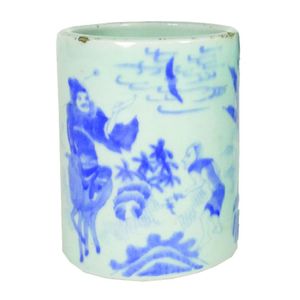Turquoise Semi-Clad Maiden Jumping Vase by Minton
You must be a subscriber, and be logged in to view price and dealer details.
Subscribe Now to view actual auction price for this item
When you subscribe, you have the option of setting the currency in which to display prices to $Au, $US, $NZ or Stg.
- Pâte-Sur-Pâte - Pâte-sur-pâte is a decorative technique that is commonly used in ceramics and glassmaking. The term "pâte-sur-pâte" is French and it translates to "paste on paste." This technique involves the application of layers of clay or glass paste to create a three-dimensional design.
In ceramics, the technique involves applying successive layers of a clay slip onto a piece of pottery. Each layer is allowed to dry before the next one is applied. The layers are then carved or incised to create a design in relief. This technique is often used to create delicate and intricate designs, such as figures or floral motifs.
In glassmaking, the technique involves applying layers of molten glass onto a blown glass form. The layers are then carved or etched to create a design in relief. This technique is often used to create intricate designs, such as floral motifs or animals.
Both techniques require a high level of skill and precision, as the layers must be applied and carved with great care to achieve the desired effect. The end result is a beautiful and unique piece of art that showcases the artist's talent and mastery of their craft. - Circa - A Latin term meaning 'about', often used in the antique trade to give an approximate date for the piece, usually considered to be five years on either side of the circa year. Thus, circa 1900 means the piece was made about 1900, probably between 1895 and 1905. The expression is sometimes abbreviated to c.1900.
- Important - Important is a word used in the antique trade to indicate an object should be ranked above other similar objects, and is therefore more valuable.
The object could be considered important because it is by a famous designer or maker, has been shown at a major exhibition, is of exquisite workmanship, is rare or is a "one-off", was made for an important patron, and so on.
Even further up the pecking order are objects that are described in catalogue descriptions as highly important or extraordinarily important.
This item has been included into following indexes:
Visually similar items

A Japanese stoneware vase, 20th century, painted with an abstract floral design, signed Anzan or Yasuyuma, 17 cm high

A Chinese porcelain blue and white brush pot, cylindrical shape, decorated with a figure riding a deer in a landscape. Height 14 cm

Orrefors studio glass vase by Olle Alberius in blue tones with seagulls and wave pattern, signed to base and numbered Ariel 522-E7

Clarice Cliff, Bizarre' Vase, c.1935, Fragrance' pattern, raised shape number '630' and factory marks to base 'Hand Painted Bizarre by Clarice Cliff Wilkinson Ltd England, height 20 cm
